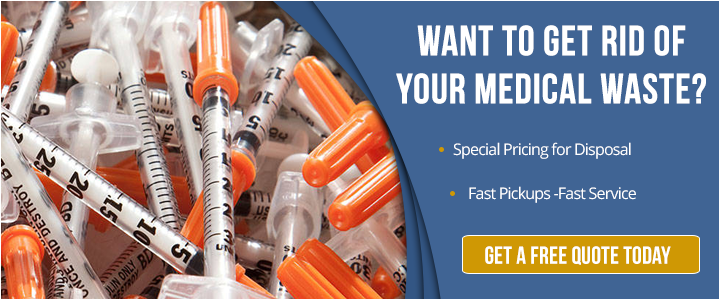Medical waste management accounts for the collection and disposal of items that come from the treatment and diagnosis of people in a hospital, medical office or laboratory setting. Most of the generated waste is harmless, but some of it poses great safety and health concerns, so there are important procedures to follow for biohazard waste disposal. A key element in proper disposal is segregating regulated wastes in medical waste disposal containers.
What is Regulated Waste?
Although not all wastes from healthcare facilities require specific disposal procedures, the term "medical waste" tends to refer to those wastes that do have segregation and containment requirements. The World Health Organization identifies  certain wastes that pose a risk and need special attention:
certain wastes that pose a risk and need special attention:
- Anatomical wastes (body parts, organs)
- Items contaminated by blood and body fluids (bandages, dressing material)
- Sharps (needles, broken glass)
- Pharmaceutical wastes (disinfectants, medicines)
- Infectious wastes (materials or body fluids capable of passing disease)
- Radioactive healthcare waste (low-level ionizing radiations used in imaging procedures)
- Hazardous wastes (chemicals, pressurized devices)
There's no federally regulated definition of the term, and states have the liberty to identify and define for themselves those wastes which must be regulated in as little or as much detail as they please.
OSHA identifies the wastes that require specific containment in the Bloodborne Pathogen Standard, They are deemed "regulated waste" because they have the potential to harm people by infecting them.
Containers
Once medical waste is generated, it obviously must have somewhere to go. Healthcare facilities must take care to ensure that their waste management plans cover the housekeeping necessities while also remaining in compliance with environmental and worker safety laws. Medical waste disposal containers are at the center of a waste management plan.
To understand the importance of a suitable container, you have to consider its purpose. The job of these containers is to safely store the materials until they are taken from the property. To be effective, containers must be able to resist punctures and leaks and stand up to tampering, fire damage, and tumbling over. It's important to consider a container's compatibility with OSHA's Bloodborne Pathogen Standard, DOT's Hazardous Materials Regulations, and EPA's Resource Conservation and Recovery Act. It is also imperative that workers are trained so that the containers are used correctly, consistently, and in line with your waste disposal company.
Container Identification
The United States does not require what color waste containers should be, only that they are color-coded. OSHA's Bloodborne Pathogen Standard addresses the issue in 29 CFR 1910.1030(d) by requiring only that all employees "recognize the containers as requiring compliance with Universal Precautions." If your state doesn't impose any color requirements, it is necessary that your company or organization do. This way, all workers consistently can practice waste disposal protocol.
Color Coding
Remember, most of these are not all federally regulated, but they are common practice in the states.
Red (or fluorescent red-orange) The only federally regulated color that is used in medical waste containers. It is used to indicate that the enclosed material consists of biohazardous waste. This is also the color used for sharps containers.
Yellow This is typically used for containers that hold trace amounts of chemotherapy waste. Some facilities use it on linen containers.
Black This holds RCRA regulated hazardous materials such as P-listed drugs.
Blue This is the color often used for non-RCRA pharmaceutical wastes, like antibiotics.
Types and Sizes
Waste containers in a fast-moving and sensitive environment like the medical field must be versatile, available, and reliable. A quick internet search will show you the many available options. There are stand-alone baskets, wheeled carts, and wall-mounted receptacles. They can range in size from 1 quart to 20 gallons of capacity.
Disposal Services
OSHA (or any other federal agency) does not regulate the disposal of medical waste, so it's important to research your disposal options. It's a good idea to work with a waste disposal service who is knowledgeable about medical waste and who has partnerships with treatment and disposal facilities.
Depending on the needs of your company, it may be wise to work with an experienced and properly licensed waste disposal company. Experts can help you to profile your waste, conduct routine pickups, and deliver to the disposal site.


Comment